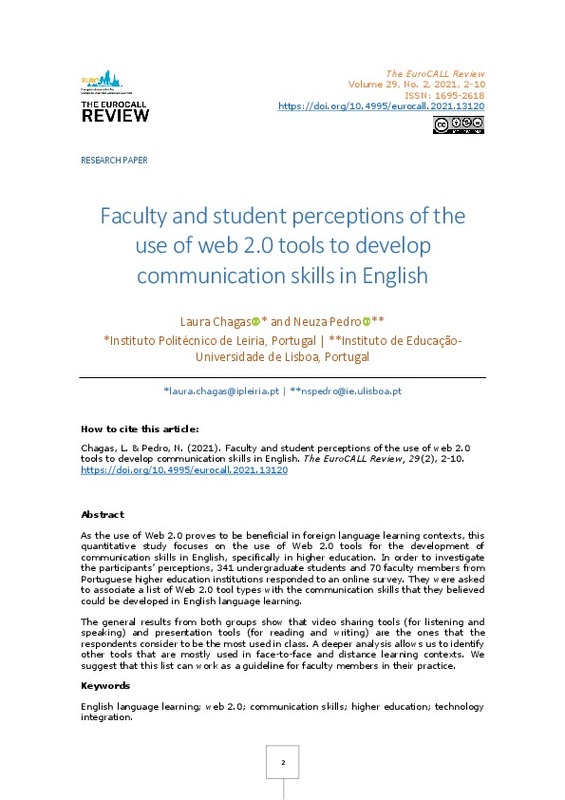Bower, M. (2015). A typology of Web 2.0 learning technologies. Educause (47), 763-777. https://doi.org/10.1111/bjet.12344
Bueno Alastuey, M. C. (2011). Perceived benefits and drawbacks of synchronous voice-based computer-mediated communication in the foreign language classroom. Computer Assisted Language Learning, 24(5), 419-432. https://doi.org/10.1080/09588221.2011.574639
Cardoso, S., Cavalheiro, L. & Branco, J. (2018). The use of technology for English language learning and teaching: some examples. In L. Cavalheiro (Org.), Preparing English Language Teachers for Today's Globalized World (pp. 159-176). Ribeirão - V. N. Famalicão: Edições Húmus.
[+]
Bower, M. (2015). A typology of Web 2.0 learning technologies. Educause (47), 763-777. https://doi.org/10.1111/bjet.12344
Bueno Alastuey, M. C. (2011). Perceived benefits and drawbacks of synchronous voice-based computer-mediated communication in the foreign language classroom. Computer Assisted Language Learning, 24(5), 419-432. https://doi.org/10.1080/09588221.2011.574639
Cardoso, S., Cavalheiro, L. & Branco, J. (2018). The use of technology for English language learning and teaching: some examples. In L. Cavalheiro (Org.), Preparing English Language Teachers for Today's Globalized World (pp. 159-176). Ribeirão - V. N. Famalicão: Edições Húmus.
Fattah, S. F. E. S. A. (2016). The Effectiveness of Using Blogs as an Independent Learning Tool to Develop Reading Skills for University Students. Journal of Education and Practice, 7(32), 65-73.
Gerhards, J. (2014). Transnational linguistic capital: Explaining English proficiency in 27 European countries. International Sociology, 29(1), 56-74. https://doi.org/10.1177/0268580913519461
González Otero, R. (2016). Innovative resources based on ICTs and authentic materials to improve EFL students' communicative needs. In A. Pareja-Lora, C. Calle-Martínez, & P. Rodríguez-Arancón (Eds), New perspectives on teaching and working with languages in the digital era. Dublin: Research-publishing.net, 83-92. https://doi.org/10.14705/rpnet.2016.tislid2014.424
Gonzalez-Vera, P. (2016). The e-generation: the use of technology for foreign language learning. In A. Pareja-Lora, C. Calle-Martínez, & P. Rodríguez-Arancón (Eds), New perspectives on teaching and working with languages in the digital era. Dublin: Research-Publishing.net, 51-61. https://doi.org/10.14705/rpnet.2016.tislid2014.421
Gruba, P. (2018). Technology for Teaching Listening. In J. I. Liontas. The TESOL Encyclopedia of English Language Teaching (pp. 1-5). Wiley Online Library. https://doi.org/10.1002/9781118784235.eelt0442
Hubbard, P. (2013). Making a case for learner training in technology enhanced language learning environments. Calico Journal, 30(2), 163-178. https://doi.org/10.11139/cj.30.2.163-178
Kemp, C., Li, P., Li, Y., Ma, D., Ren, S., Tian, A., Wang, D., Xie, L., You, J., Zhang, J., Zhu, L. & Zhuang, H. (2019). Collaborative Wiki Writing Gives Language Learners Opportunities for Personalised Participatory Peer-Feedback. Shaping Future Schools with Digital Technology, 147-163. https://doi.org/10.1007/978-981-13-9439-3_9
Le, T. (2018). Voice Recording in second language outside the classroom: Process and product. Journal of NELTA, 23(1-2), 129-141. https://doi.org/10.3126/nelta.v23i1-2.23357
Levak, N., & Son, J. B. (2017). Facilitating second language learners' listening comprehension with Second Life and Skype. ReCALL, 29(2), 200-218. https://doi.org/10.1017/S0958344016000215
Nobre, A., & Relvas, M. D. J. (2015). Avaliação alternativa digital da oralidade "Em Qualquer Lugar do Mundo". In T. Cardoso, A. Pereira & L. Nunes. Avaliação e tecnologias no ensino superior (pp. 38-51). Lisboa: Universidade Aberta.
Peeters, W. (2018). Applying the networking power of Web 2.0 to the foreign language classroom: A taxonomy of the online peer interaction process. Computer Assisted Language Learning, 31(8), 905-931. https://doi.org/10.1080/09588221.2018.1465982
Shen, H., Yuan, Y., & Ewing, R. (2015). English learning websites and digital resources from the perspective of Chinese university EFL practitioners. ReCALL, 27(2), 156-176. https://doi.org/10.1017/S0958344014000263
Trinder, R. (2017). Informal and deliberate learning with new technologies. ELT Journal, 71(4), 401-412. https://doi.org/10.1093/elt/ccw117
Venkatesh, V., Croteau, A. M., & Rabah, J. (2014). Perceptions of effectiveness of instructional uses of technology in higher education in an era of Web 2.0. In 2014 47th Hawaii international conference on system sciences, 110-119. Washington: IEEE Computer Society. https://doi.org/10.1109/HICSS.2014.22
Walker, A., & White, G. (2013). Technology Enhanced Language Learning: connecting theory and practice-Oxford Handbooks for Language Teachers. Oxford: Oxford University Press. https://doi.org/10.1093/elt/cct069
Wilkinson, M. (2016). Language learning with ICT. In W.A. Renandya & H.P. Widodo (Eds.), English Language Teaching Today, English Language Education, Vol. 5 (pp. 257-276). Switzerland: Springer International Publishing. https://doi.org/10.1007/978-3-319-38834-2_18
Zou, B., Wang, D., & Xing, M. (2016). Collaborative tasks in Wiki-based environment in EFL learning. Computer Assisted Language Learning, 29(5), 1001-1018. https://doi.org/10.1080/09588221.2015.1121878
[-]









